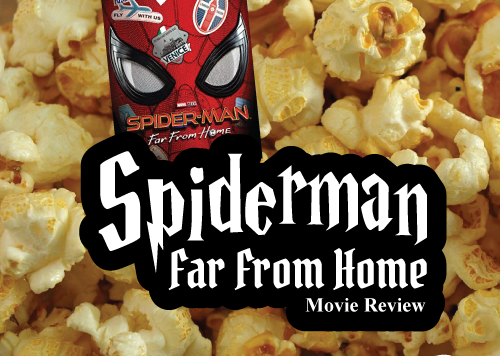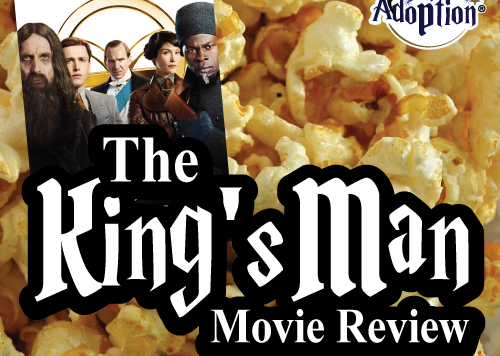Transfiguring Adoption’s Overview:
Tom & Jerry (2021) really has no overt connections to adoption or foster care but does have some themes that foster or adoptive children may relate to, such as learning to get along with others, building bonds with found family, and communication. Children that have endured trauma often miss out on social and emotional skill-building and can lead to miscommunication and conflict as seen with Kayla Forester (the heroine of the movie played by Chloe Grace Moretz) and her coworkers as well as between Tom and Jerry. The target audience appears to be children that are ages 8 and up. It also appears this movie would be best for most families to enjoy as long as children have a caring adult watching with them.
** Spoilers Could Be Ahead **
How Is This Relevant To Adoption & Foster Care?
As I mentioned before, Tom & Jerry (2021) really has no overt connections to adoption or foster care. Your children may resonate with some themes that foster or adoptive children may relate to, such as learning to get along with others, building bonds with found family, and communication. Children who have endured trauma often miss out on social and emotional skill-building and can lead to miscommunication and conflict as seen with Kayla Forester (the heroine of the movie played by Chloe Grace Moretz) and her coworkers as well as between Tom and Jerry.
Throughout the movie Kayla is shown as having lots of ambition, resourcefulness, and charm but lacks connections, support, and experience. Kayla shows a desire to show others that she can make a name for herself but really doesn’t have much direction in how to achieve this. She jumps on a chance of a lifetime when the Royal Gate Hotel has a position open for an upcoming celebrity wedding of locals Preeta Mehta and Ben (who also struggle with communication with one another). The problem is that Kayla is in no way qualified for this position and lies about her identity and steals another candidate’s resume to get this job. For the rest of the movie Kayla ends up spending more energy keeping up with lies and cover-ups than on the job itself and shenanigans ensue. Over the course of the film Kayla learns that being honest and learning from mistakes is very important in building up who she truly is and that nurturing her true self and skills is more valuable in building lasting relationships with others.
Tom and Jerry also have to learn along the way to either live together in peace or they both will have lasting consequences to their overall wellbeing. Not only do both move to New York City alone with no support, but they are homeless and reliant on gimmicks and tricks to get by. Much like Tom and Jerry, children who have endured trauma have had to find creative ways to survive but these survival tactics that once were life-saving become extremely chaotic and challenging to a new family that wants to offer all the love and care they believe a hurting child needs. But, as seen with Tom and Jerry, a new job and lodging doesn’t resolve past conflicts/trauma or all the needs someone may realistically bring into a new home.
Tom & Jerry (2021) may not be the best portrayal of a movie for children in foster care, but for these reasons a caregiver may have a chance to bond with their child and share a good experience together.
Discussion Points:
-
- Getting Along with Others
Think back to your playground days. At some point in your youth I’m sure that you recall having a fight with a friend over a toy. And then another for who slapped the other. Over and over as a young child you had disagreements with peers, siblings, cousins, and others and (hopefully with the guidance of caring adults along the way, learned ways to cope with big feelings, express your concerns in an appropriate manner, and then work together to solve the problem. Over time your brain grew more comfortable with these skills with all the practice and this helped structure pathways in your prefrontal cortex to aid you in emotional regulation, language development, connecting feelings to behavior, and problem-solving. This also helped you to learn that some conflict is a healthy part of relationships that help repair and strengthen relationships.
Children who have endured trauma often lack these experiences that their growing brains need over time with the love, consistency, and patience an attuned adult provides to such experiences. A child who has a history of trauma may react to conflict in a few ways: fight, flight, freeze, or check-out. This is because your child has cognitive deficits in the frontal lobe from the lack of practice in conflict and is usually relying on the limbic system to handle conflict… because conflict is perceived as danger and the brain is using the easily accessible pathway to find safety. This can look like fighting to scare a threat off, running away to create physical space, freezing because the flood of adrenaline and cortisol is shutting down that child’s ability to process what is happening around them, or completely checking-out to create safety in a situation that child cannot physically run from for whatever reason. So for this reason, you are going to need to meet your child at that limbic system first, bring that child to calm, and only then can you reason and learn new skills. Much like Tom when Jerry smashes up his piano act, your child likely is acting purely on the instinct built by the limbic system of the brain and it will require lots of guidance from you, the caregiver, to overcome years of trauma responsiveness. Especially if you have another reactive child, like Jerry, who is also acting upon instincts to stir up conflict for adrenaline seeking purposes as a trauma response or is also lacking in social skills. - Communication
This very much goes hand-in-hand with the point above about how trauma can cause large deficits in the prefrontal cortex, which is located in the frontal lobe of the brain. This is part of the brain where language is developed and processed. This is very important because often trauma-exposed children use language skills they have never had! For children who have endured trauma, they can feel much like Tom and Jerry after having a knock-down, drag-out fight in the hotel atrium and having no ability to explain how the conflict escalated to that height. Your child not only lacks the literal words at times for how they feel, they may also lack the ability to connect those feelings to their own behavior. Deficits are also further impeded by emotional escalation because when the brain is hyper-aroused it is harder to access the prefrontal cortex because so much activity is often happening in the limbic system. In short? The angrier you are, the stupider you become according to science. With that in mind, once we have calmed down our child (or children, as often where one child melts down another shall follow) then we can practice healthy communication tools to communicate needs, connect feelings to behaviors, and plot out new plans for success in the future. It won’t change overnight, much like Tom and Jerry, but more practice and commitment to the relationship will over time help your child succeed and give you a more peaceful home! - Found Family/Relationship Building
When I was a new step-parent, I was extremely nervous. I had never raised a child in-home before and absolutely adored my young step-daughter, but found for the first couple of years building the relationship with my new family member was much harder than I expected. I watched my friends have biological children and seem to have an instant bond with their babies and toddler and often cried because I was terrified I could never have such a loving, strong bond with my new daughter (who I met when she was 7 years old). Thankfully for me, at that time I began to teach foster parenting classes and learned more about the subject of attachment building than I ever did in college. I learned that it was perfectly normal for me and this little, strong-willed girl to not instantly “click”. I learned that though she was very excited to have me in the home, the trauma from divorcing parents, several moves, and changing home dynamics made it hard for my sweet little girl to trust others, including adults, and that this wasn’t something for me to take personally. On top of that, I learned that my step-daughter mouthing off to me, dumping out ketchup bottles, throwing tantrums over foods and clothing, and all of that mess was actually a beautiful sign that this little girl was starting to trust me, the adult, with her big, complicated emotions that she couldn’t handle alone. Over time, I was able to use my professional trauma information on parenting and change how I responded to my child’s cries for help even when she didn’t know what she was asking for and this completely changed the face of my home and marriage. Now my teenager is comfortable walking up to me and telling me “I need a hug because I missed you” or “I need down-time so I can recharge” or “I need to talk without you freaking out” because she knows that she is 100% safe in this relationship.
Your child may have quite the family surrounding them. Biological family, adoptive family, foster family, friends as found family, all sorts of relationships that can have the potential to heal. For this to happen though, it is up to the caregiver to show them, over and over again, that they are safe by listening to their communication cues for needs to meet their needs, bring down the scary conflict monster music in the background of their minds, and help them trust the relationship with honesty. Think of how Ben tries too hard with over-the-top gestures and how Preeta tip-toes about the relationship, afraid to voice her needs. Both grew frustrated over time and were ready to give up. Like Ben, we need to show that we are listening, prepared for if the need is different than what we want, and meet the child where they are at to have great honest communication and a safe haven in your relationship.
- Getting Along with Others
Cautionary Points:
-
- Cartoon Violence
Throughout the film there are several sequences of unrealistic cartoon violence and antics that most parents will expect from cartoon icons such as Jerome Mouse and Thomas Cat. The biggest warning of caution with these sequences is that there are few to no lasting consequences to these sequences of violence and action (which are all very exaggerated and unrealistic to begin with) but if you have a child who is prone to mimic such acts of violence like smashing someone with hammers, playing with mousetraps, getting hit by a truck, shipping a sibling or friend out of the country, throwing others or self against a wall, slamming body parts in doors, falls, destroying rooms/buildings/property, throwing hot irons at others, having drones or smart-skateboards harm others, use power tools inappropriately, drop heavy objects like bowling balls on others, or trying to use cardboard boxes to fashion wings to glide off a building in a lightning storm then you may want to proceed with this movie with a fair amount of caution. There are no sequences that result in characters being bloodied, maimed, or harmed in long-term ways in this film. - Lying and Stealing Throughout the Film
For a movie with main characters that can’t talk there is a ton of lying in this movie committed by the “good guys”. Kayla, the heroine of the story alongside Tom and Jerry, lies to get the hotel job and continues to do so to cover up her original lies throughout the film. She also steals a resume to apply for the job and makes many questionable choices throughout the film. While she does receive some consequences when the lies catch up to her, at the end of the film she still gets to work for this hotel because of an apology, which is not very realistic with how far some of these lies went. There are “soft” lies throughout the film too as Preeta and Ben navigate being a celebrity couple with an image to maintain leading up to their wedding. Preeta and Ben do eventually learn that being honest about how they feel is more important than their celebrity image and grow from it, but not without a last minute feel-good wedding scene to wrap up the movie. Additionally, at the start of the film Tom is playing piano in a park pretending to be blind for sympathy tip money and Jerry disrupts his set by stealing his act. One of the larger instances of stealing throughout the movie is Jerry stealing from the hotel and its patrons to live in a hole in the wall and furnish his new place. Jerry even goes as far to steal Preeta’s engagement ring and use this as leverage forfavors. This may be problematic for children who struggle with past trauma in the form of survival behaviors such as lying and stealing as it may normalize such behaviors. - Animal Violence
Beyond Tom and Jerry’s hijinks there are several instances of animals fighting, chasing, and stampeding. This includes elephants, tigers, dogs, cat scratching, peacocks, and an alley-cat gang. There are also sequences of the alley cats threatening harm towards others in a gang-like manner, and Terrance roughly throwing Tom out on the street after manipulating him and Jerry against one another.. This may be a struggle for children with animal-specific trauma or fears as each child is different and may interpret these scenes differently. No character is ever bloodied, maimed, or forever injured by the activities in the film but a caregiver should be wary if their child may be sensitive to such content. - Adults Shown as Angry or Incompetent
Throughout the entire movie most of the adults, especially those that are in authority positions are portrayed as angry and vengeful or very incompetent. The hotel manager, Terrance, throughout the movie very clearly sees through Kayla’s ploys but approaches conflict much like Chef Jackie in the kitchens… angry, loud, and vengeful. Both characters approach emotionally abusive towards their colleagues if not physically and financially abusive (i.e. – throwing things, threatening jobs/livelihood/etc.). DuBros, the hotel owner, appears completely oblivious to every manipulation and plot to the point of absurdity and relies on a part-time, young staffer for advice far more than appropriate for such large events. While this surely is to play into the big, over-the-top hijinks for the movie this can be a poor portrayal for children who have endured trauma of adults. And even though Kayla is technically an adult, let’s be honest and recognize that many children are going to look to Moretz’s character as a younger person to relate to and see the message “adults cannot be trusted” be reinforced. For this reason some caregivers should avoid this film with caution.
- Cartoon Violence
- Harsh Living Conditions, Homelessness, and Joblessness
Throughout the film Kayla, Jerry, and Tom all experience harsh living conditions, homelessness, and joblessness. Jerry is shown touring very substandard living spaces including an abandoned car glovebox that features filth, flammable carseats, roaches, and a body outline from an implied murder before choosing the squat in the hotel with stolen items. Tom is shown living in cardboard boxes in the rain, and Kayla is implied to be homeless when she jumps on the opportunity for a job that includes living spaces/expenses. Children who have been through neglectful situations should be monitored while viewing this film for this reason. Though most of the depictions are cute and cartoony, these experiences may still trigger memories of times they may have experienced.
- Inappropriate Humor
What is an old-school franchise without some inappropriate humor “snuck in” for parents, right? As a parent myself it surprises me what kinds of things make it past censors for kids movies (thanks a lot, Animaniacs!!!). This movie includes peacocks raising their feathers up in response to peahens to reflect a family-friendly erection, a character being censored while saying “Why the F- not?!?”, Jerry taking butt-photocopies on a photocopier, and smaller slapstick effects like a flying cork hitting an elephant in the butt. Children who have more mature experiences than their peers may catch on to such sequences, see the response from adults, and start mimicking these sequences, much to your dismay when you will absolutely be in public or with a caseworker. This is another one that caregivers may evaluate for each child in their care, but again does deserve a heads up.
- Animal Control Resembles Jail
Whenever Tom and Jerry encounter Animal Control they react much like it is a police encounter and run/hide from the Animal Control Officer. When they enter the Animal Shelter, this is also depicted like a jail situation complete with one dog being chained up with a Hannibal Lecter mask and all. There is also a reappearance of the alley cat gang engaging in bullying behavior during this sequence. Children who have endured the incarceration of a loved one or have poor experiences with police-like figures may struggle with these depictions even at younger ages. I personally have seen two toddlers dive under a table saying “The police are here, HIDE!” in response to a passing security guard in a professional building. It’s important for caregivers to be sensitive to such trauma triggers regardless of age.
- Appearance of Alcohol Consumption
This pops up surprisingly more than I expected but I hope in ways that will mostly fly over most kid’s heads. Throughout the movie Cameron, the hotel bartender and Kayla’s love interest, offers drinks to Kayla in a friendly way and she at one time does consume champagne as a reward for catching Jerry. Another sequence features Jerry enjoying bubbly champagne-colored beverages in a martini glass with olives. While later on in the scene an adult can clearly read on the bottle label it’s sparkling cider, a child may not recognize the label and just see Jerry living large in a fancy hotel room guzzling alcoholic beverages. For most kids this may not be a big deal, but for a child who has endured trauma from caregivers consuming such beverages and resulting in fights like Tom and Jerry this may be triggering.
- Concerning Behaviors Towards and From Joy
As we say in the South, “Bless her heart!” Joy is depicted as a very socially awkward young woman who works as a bellhop in the hotel and is frequently the punching bag for verbal abuse from Terrance (who spreads a rumor she was raised by wolves and is just overall mean to her). Joy also, sadly, also says a few concerning things in the writer’s attempts to highlight her social awkwardness. This includes her telling Kayla that she lost her baby brother and not to tell anyone. This was a one-line bit that never comes back but still could be as problematic for a child who has endured abandonment and neglect just as much as how characters bully her can trigger a child who has been bullied. For this reason a caregiver should be aware of this in case their child struggles with this.
Transfiguring Adoption is a nonprofit organization seeking to nurture growth in foster and adoptive families by giving a HOOT about their families. Transfiguring Adoption does not intend for its reviewers nor its reviews nor this discussion packet to be professional, medical or legal advice. These reviews and discussion guides are intended to help parents to better be able to connect and understand their children who come from traumatic backgrounds.
About the Reviewer: Rachael Rathe
Rachael B. Rathe is an East Tennessee native with a Bachelor of Arts Degree in Psychology with a Minor in Child & Family Studies from The University of Tennessee Knoxville. She has worked in mental health since 2013 and in foster care/adoptions for a private provider agency since 2014. Rachael was inspired to work in the field after working with children and teens on a volunteer basis 2008 – 2013. Rachael’s ideal self-care day involves snuggling on a couch with her kitties (Tabitha, Fergus, and Rufus) while enjoying a good movie or book. She also enjoys galavanting around conventions concerning all things nerd and geekery.





